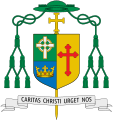English: Coat of arms of the U.S. bishop Peter Joseph Jugis, Bishop of Charlotte.
It is tradition for every bishop to have his own coat of arms and motto.
Similar to many bishops' coats of arms, Bishop Peter J. Jugis' coat of arms is composed of the shield with its charges, motto and external armaments. But the details of the design and the motto have special significance to Bishop Jugis.
"Bishop Jugis impales his personal heraldic device onto the arms of this diocese to represent his governance of the people of God in the church of Charlotte," explained Father James Parker, a priest of the Diocese of Charleston, S.C., who designed the coat of arms.
Father Parker is a heraldic designer who has devised arms for cardinals, other members of the hierarchy and various church institutions. He is a member of the Heraldry Society of England, Scotland, Canada and the American Society of Heraldry.
The coat of arms' artwork is by Father Larry Lossing, a priest of the Diocese of Orlando, Fla., and a professional artist.
The impalement also represents the mystical "marriage" between the local ordinary and his jurisdiction, said Father Parker.
To the viewer's right (the shield bearer's left or sinister side behind the shield) is a gold field, which represents the great treasure of the faith and the hope of salvation offered to us all by the gift of redemption, according to Father Parker. Gold also stand for the enrichment of life given by redemption, he said.
"With the gold background, I wanted to tie in the years that I studied in Rome and my priestly ordination by the pope," said Bishop Jugis. "The colors of Vatican City are gold and silver, so I chose the gold background for my coat of arms."
"Gold is also a reference to Our Lady, who in the Litany of the Blessed Virgin Mary, is called 'House of Gold,'" said the bishop, "Gold is a precious metal, and Mary, as the mother of Christ, was the most precious 'house,' or dwelling place, of God"
The cross is in a style called "bottony" in heraldry because it has three circles at the end of the staff and the cross arms. This has personal significance to the bishop and thus is a personal "badge" for him, said Father Parker.
"The design of the cross that I chose was inspired by a crucifix hanging in the living room of the rectory at Our Lady of Lourdes Church in Monroe," said Bishop Jugis. "It is a beautiful wood-carved crucifix that I believe goes back many years at the parish there."
"The cross reminds us of salvation wrought by Jesus Christ crucified and the red color suggests the precious blood, the cost of redemption," said Father Parker.
"Red is to emphasize the blood and sacrifice of Christ for us," said Bishop Jugis. "The paschal mystery-one of the central mysteries of our faith; the mystery of the suffering death and rising of Christ- is all symbolically represented right there in the cross."
"The three circles on the cross ends denote the Blessed Trinity, whom we worship," said Father Parker.
The arms to the viewer's left (the shield bearer's right or dexter side behind the shield) are the escutcheons of the Diocese of Charlotte, explained Father Parker.
"The field is divided horizontally into green and blue portions. In the chief or upper half is a Celtic cross of silver-edged gold, which represent St. Patrick, patron saint of the cathedral church of the diocese," said Father Parker. "In the lower left part, the crown denotes Queen Charlotte, consort of George III of England. The see city is named for her."
Behind the coat of arms is a gold processional cross.
The shield is ensigned with the green heraldic hat having six "houppes," or tassels, depending from either side, denoting the hierarchical rank of a bishop in accordance with the Instruction of the Holy See (March 31, 1969). Before 1970, the pontifical hat was worn at solemn cavalcades in conjunction with papal ceremonies. The color of the hat and number of tassels were signs of the rank of the prelate, a custom still preserved in ecclesiastical heraldry.
Bishop Jugis' motto, "Caritas Christi Urget Nos" ("The Love of Christ Urges Us On"), comes from St. Paul's second pastoral letter to the Corinthian Church, said Father Parker, and offers the inspiration for growth and formation in the faith, which the bishop wished to inspire in the people as their pastor.
"I wanted to have a motto that would somehow include Christ's love in it," said Bishop Jugis. "The love of Christ is planted in our hearts from the day of our baptisms. I remember the line from Paul's letter to the Romans- "the love of God has been poured out into our hearts through the Holy Spirit, who has been given to us." That love should be the reason and motivation for everything we do as Christians and for me as shepherd of the diocese."
"After I had chosen it, I discovered the saint whose feast day is celebrated Oct. 2 — 4St. Anthony Mary Claret — the very day I'm being ordained, has the same motto," he said. "I thought it was an interesting coincidence."
Reference:

